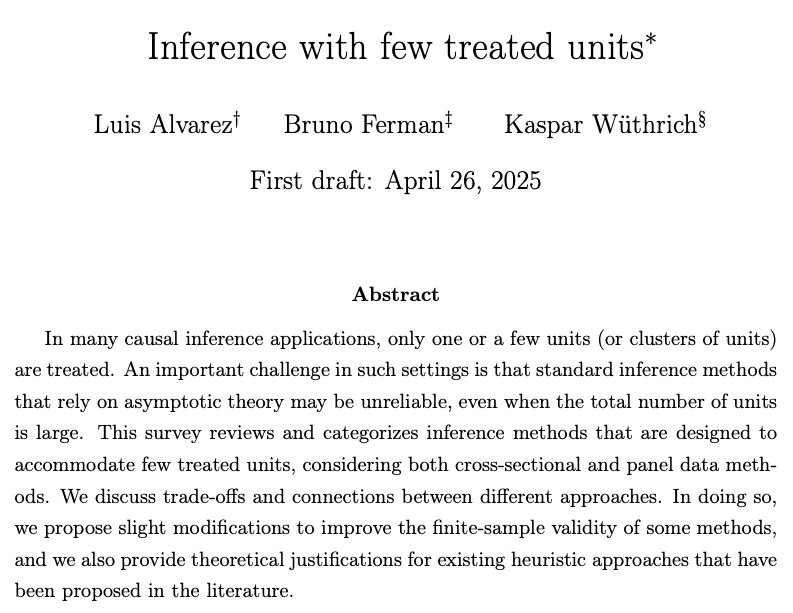
Bruno Ferman
@bruno_ferman
Followers
2K
Following
2K
Media
17
Statuses
849
Professor at Sao Paulo School of Economics (@EconFGVSP/@EconomiaGV)/Econometrics/Applied Micro/affiliate @JPAL
Sao Paulo, Brazil
Joined March 2020
I’ll keep as my pinned Tweet links to the threads my co-authors and I wrote on our papers:. 1) Ferman and Pinto: Inference in DID with few treated. @cristinepinto16.
💡 Inference in difference-in-differences with few treated clusters 💡. Ferman and Pinto (2019) was published a couple of years ago, when I was not on Twitter. But I think it’s not too late to write a thread on it. 1/12
1
6
20
RT @PossebomVitor: 💡New Working Paper💡Nonlinear Treatment Effects in Shift-Share Designs.with @luigieras. Link: S….
0
23
0
RT @RevEconStudies: "This study estimates the carbon-efficient forest cover in the Brazilian Amazon. A $10/ton carbon tax could preserve 95….
0
53
0
RT @PossebomVitor: Are you unsure about how to conduct inference when you only have a few treated units?. @lafalvarez, @bruno_ferman, and W….
0
8
0
RT @bruno_ferman: 🧵New survey paper: "Inference with Few Treated Units" .Alvarez (@lafalvarez), Ferman (@bruno_ferman) and Wüthrich. Tired….
0
91
0
@Lycia_Lima @friva_ 8) Alvarez, Ferman and Wüthrich: Inference with Few Treated Units. @lafalvarez .Kaspar is no longer with us on #EconTwitter. .
🧵New survey paper: "Inference with Few Treated Units" .Alvarez (@lafalvarez), Ferman (@bruno_ferman) and Wüthrich. Tired of referees saying your standard errors are wrong?. This survey will help you understand if you really have a problem — and, if so, how to fix it!
0
0
2
That's a quick overview!. For more details, check out the full survey 📚👇. Link: Hope you find it helpful!.Feedback welcome. 🧠✍️.
arxiv.org
In many causal inference applications, only one or a few units (or clusters of units) are treated. An important challenge in such settings is that standard inference methods that rely on...
0
0
5
9/.Ferman and Pinto (2019): allow for heteroskedasticity that can be estimated based on observables. Example: when units have different variances due to variation in population sizes. See this old thread:
💡 Inference in difference-in-differences with few treated clusters 💡. Ferman and Pinto (2019) was published a couple of years ago, when I was not on Twitter. But I think it’s not too late to write a thread on it. 1/12
1
0
0




